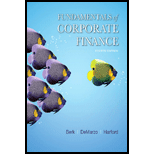
Cumulative voting: Cumulative voting is a method of election in a company for electing a board of directors, where each shareholder is given one vote for a share multiplied by the number of vacant positions for directors. It is the choice of a shareholder to cast votes among several directors or to give all the votes to one director only.
Straight voting: Straight voting is a method of election in a company where each shareholder is given a vote for a share and votes must be divided equally among the candidates. For example, if there are two persons standing as a candidate for the position of directors. A shareholder who has five shares will be able to vote five times for each candidate.
To determine:
The representation of votes when the company has cumulative voting or straight voting.
Want to see the full answer?
Check out a sample textbook solution
Chapter 7 Solutions
Fundamentals of Corporate Finance (4th Edition) (Berk, DeMarzo & Harford, The Corporate Finance Series)
- You just bought a new car for $X. To pay for it, you took out a loan that requires regular monthly payments of $1,940 for 12 months and a special payment of $25,500 in 4 months. The interest rate on the loan is 1.06 percent per month and the first regular payment will be made in 1 month. What is X?arrow_forwardYou own 2 investments, A and B, which have a combined total value of $38,199. Investment A is expected to pay $85,300 in 6 years and has an expected return of 18.91 percent per year. Investment B is expected to pay $37,200 in X years and has an expected return of 18.10 percent. What is X?arrow_forwardYou own 2 investments, A and B, which have a combined total value of $51,280. Investment A is expected to pay $57,300 in 5 years and has an expected return of 13.13 percent per year. Investment B is expected to pay $X in 11 years and has an expected return of 12.73 percent per year. What is X?arrow_forward
- Equipment is worth $225,243. It is expected to produce regular cash flows of $51,300 per year for 9 years and a special cash flow of $27,200 in 9 years. The cost of capital is X percent per year and the first regular cash flow will be produced in 1 year. What is X?arrow_forward2 years ago, you invested $13,500. In 2 years, you expect to have $20,472. If you expect to earn the same annual return after 2 years from today as the annual return implied from the past and expected values given in the problem, then in how many years from today do you expect to have $55,607?arrow_forwardYou plan to retire in 5 years with $650,489. You plan to withdraw $88,400 per year for 20 years. The expected return is X percent per year and the first regular withdrawal is expected in 6 years. What is X?arrow_forward
- Ends Feb 23 Explain in detail what is Risk as defined for financial assets and what is Beta? Also discuss in detail what is the Capital Asset Pricing Model (CAPM) and its purpose.arrow_forwardThe slope parameter ß1 measures the change in annual salary, in thousands of dollars, when return on equity increases by one percentage point. Because a higher roe is good for the company, we think ß1 > 0.The data set CEOSAL1 contains information on 209 CEOs for the year 1990; these data were obtained from Business Week (5/6/91). In this sample, the average annual salary is $1,281,120, with the smallest and largest being $223,000 and $14,822,000, respectively. The average return on equity for the years 1988, 1989, and 1990 is 17.18%, with the smallest and largest values being 0.5% and 56.3%, respectively.Using the data in CEOSAL1, the OLS regression line relating salary to roe is :arrow_forwardFor the population of people in the workforce in 1976, let y = wage, where wage is measured in dollars per hour. Thus, for a particular person, if wage = 6.75, the hourly wage is $6.75. Let x = educ denote years of schooling; for example, educ =12 corresponds to a complete high school education. Because the average wage in the sample is $5.90, the Consumer Price Index indicates that this amount is equivalent to $24.90 in 2016 dollars.Using the data in WAGE1 where n = 526 individuals, we obtain the following OLS regression line (or sample regression function):arrow_forward
 Essentials Of InvestmentsFinanceISBN:9781260013924Author:Bodie, Zvi, Kane, Alex, MARCUS, Alan J.Publisher:Mcgraw-hill Education,
Essentials Of InvestmentsFinanceISBN:9781260013924Author:Bodie, Zvi, Kane, Alex, MARCUS, Alan J.Publisher:Mcgraw-hill Education,

 Foundations Of FinanceFinanceISBN:9780134897264Author:KEOWN, Arthur J., Martin, John D., PETTY, J. WilliamPublisher:Pearson,
Foundations Of FinanceFinanceISBN:9780134897264Author:KEOWN, Arthur J., Martin, John D., PETTY, J. WilliamPublisher:Pearson, Fundamentals of Financial Management (MindTap Cou...FinanceISBN:9781337395250Author:Eugene F. Brigham, Joel F. HoustonPublisher:Cengage Learning
Fundamentals of Financial Management (MindTap Cou...FinanceISBN:9781337395250Author:Eugene F. Brigham, Joel F. HoustonPublisher:Cengage Learning Corporate Finance (The Mcgraw-hill/Irwin Series i...FinanceISBN:9780077861759Author:Stephen A. Ross Franco Modigliani Professor of Financial Economics Professor, Randolph W Westerfield Robert R. Dockson Deans Chair in Bus. Admin., Jeffrey Jaffe, Bradford D Jordan ProfessorPublisher:McGraw-Hill Education
Corporate Finance (The Mcgraw-hill/Irwin Series i...FinanceISBN:9780077861759Author:Stephen A. Ross Franco Modigliani Professor of Financial Economics Professor, Randolph W Westerfield Robert R. Dockson Deans Chair in Bus. Admin., Jeffrey Jaffe, Bradford D Jordan ProfessorPublisher:McGraw-Hill Education





